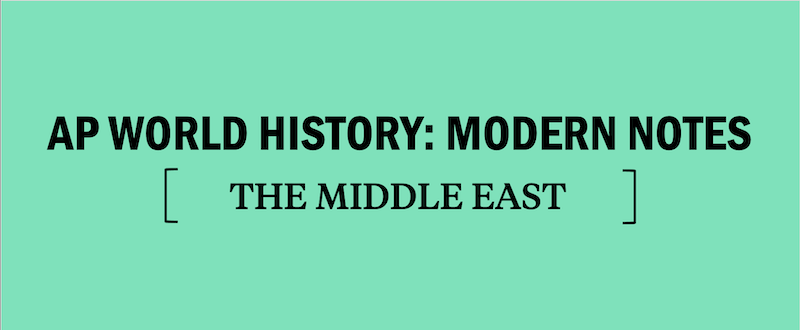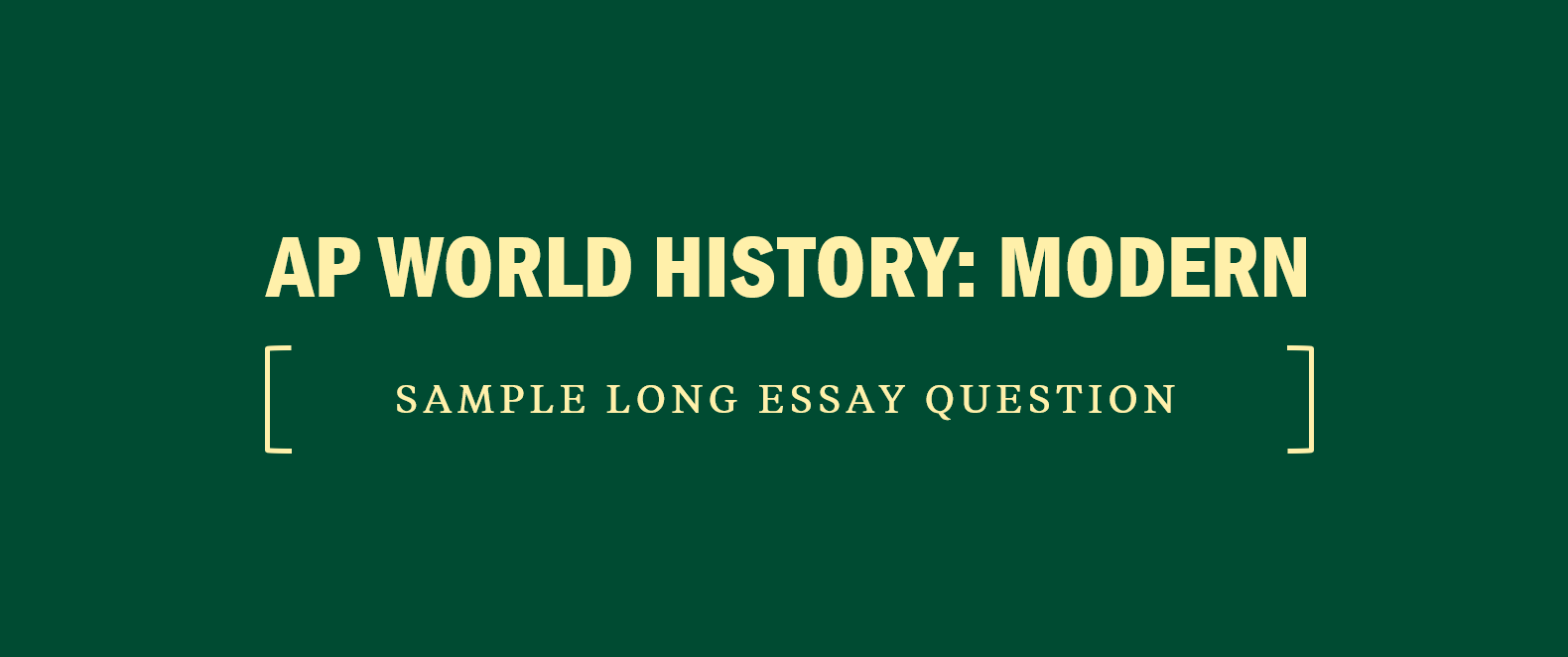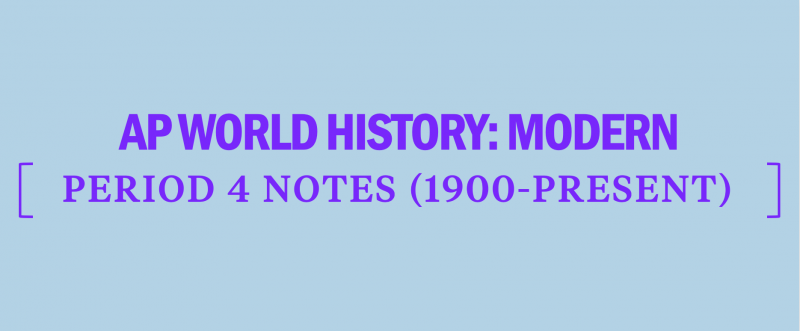AP World History: Modern Notes—Middle East
Understanding significant events in Middle Eastern history is key for success on the AP World History: Modern Exam. Read on for a review of key information about the history of the Middle East.
Table of Contents
- State-Building—Safavid Dynasty
- Sunni-Shi’a Split Widens
- Zionism and Palestinian Nationalism
- Arab Spring
Middle East Notes: State-Building—Safavid Dynasty
The formation of the Safavid Dynasty marks the beginning of modern Iranian history. The Safavids replaced the Timurid Empire, a dynasty of Turkicized Mongols, and reunified a politically fragmented Iran, ruling from 1501 to 1736. It was the first native dynasty since the seventh century. At its zenith, its empire stretched from eastern Turkey to western Pakistan and Afghanistan, and it incorporated large portions of Iraq.
The Safavid state was ruled by the Shah, but the system was a blend of royal absolutism mixed with bureaucratic checks and balances to minimize corruption and fraud. The Shah’s orders required seconding by the prime minister, who himself was audited by a deputy who reported to the Shah. The economy was agricultural, but Silk Road trade also played an important role. Shah Abbas I forced the Portuguese from the Persian Gulf in 1602 with the aid of the British East India Company, and he was able to negotiate trade agreements with British, Dutch, and French traders. However, the sea routes discovered by Europeans during the Age of Exploration meant that overland Silk Road trade declined, as did the money it brought to the Safavid Dynasty. European merchants also gradually came to monopolize trade routes in the Indian Ocean. By the early eighteenth century, a series of revolts and loss of territory led to the downfall of the Safavid Dynasty.
Middle East Notes: Sunni-Shi’a Split Widens
The Safavid Dynasty was critical in Shi’a Islam becoming the majority religion of present-day Iran. This state-sponsored conversion campaign took place over the sixteenth through eighteenth centuries and resulted in hostilities between Shiites and Sunnis, as centuries of partial accommodation for divergent beliefs in Persia were discarded in favor of state-sponsored conversion. This occasionally brutal process resulted in a great deal of ill-will from Sunnis and contributed to the long-running conflict between Iran (then Persia) and the Ottomans, even after the downfall of the Safavid Dynasty.
While the two major denominations of Islam had existed since the seventh century, the gulf between them widened in this period due to the Ottoman-Iranian Wars. These wars were a series of conflicts that took place between the sixteenth and nineteenth centuries. Not only did the two empires fight over regional power and control of territory, but the conflict was also intensified because the Ottomans were Sunni and the Safavids were Shi’a. In historical terms, the intersection of sectarianism and geopolitics in Ottoman-Safavid tensions is comparable to present-day Saudi-Iranian tensions.
This sectarian division also helped foster odd alliances, as the Safavids sought Christian European aid against a common Ottoman foe, and European powers could rely on the sectarian divide to align the Safavids against their fellow Islamic power. A formal Habsburg-Persian alliance was attempted but existed more as a matter of circumstance than a legally binding agreement. Later Safavid missions to various European courts around the turn of the seventeenth century led to agreements with Britain, and in the eighteenth century diplomatic relations were opened with the French.
The Treaty of Zuhab, signed in 1639, fixed the borders between the Safavid and Ottoman empires, which persist as the present-day Iran-Iraq and Iran-Turkey borders. After 1639, the two empires would not go to war again until 1730.
Middle East Notes: Zionism and Palestinian Nationalism
In the Balfour Declaration of 1917, the British government supported a homeland for Jews in Palestine, in line with the European Zionist movement for Jewish nationalism. Following World War I, the British ruled Palestine under a League of Nations mandate. However, Arab Palestinians saw both British rule and Jewish settlements as forms of Western imperialism. The British tried to control the violence between communities as the Jewish minority slowly grew in numbers.
At the end of World War II, the regional Pan-Arab movement joined the Palestinians in opposing the creation of a Jewish state, but the Holocaust had motivated the remaining Jewish people to find a secure homeland. By 1947, the weakened British Empire turned the question over to the United Nations, which planned to divide the area into two states. This paralleled India, in that a negotiated end to colonial rule led to violence and mass migrations between rival groups, and a war ensued. Jewish victories over the neighboring Arab nations led to the creation of the state of Israel on May 14, 1948. As Jews were expelled from newly independent Arab states in the region and relocated to Israel, Palestinian refugees from Israel resettled in cities and camps in neighboring Jordan and adjacent lands.
Both sides claim the ancient Holy Land as their national homeland, and fighting continues to plague this region. Israel fought three subsequent wars with its Arab neighbors, including the Six Day War in 1967, which expanded its territory into the Jordanian West Bank and Egypt’s Sinai. Israel and the Arab states gradually established a local “Cold War” kind of stability in the 1970s and 80s, and the Palestinian Liberation Organization (PLO) has used terrorism to press for a Palestinian state to replace Israel in the region, as has Hamas. Over time, a détente developed between Israel and Saudi Arabia in order to counter their mutual regional rival, Iran.
The oil richness of the region led to Western powers having a renewed interest in the area during the second half of the twentieth century. Notably, this occurred during the Persian Gulf War (1990–91) and the Iraq War (2003-2011).
Middle East Notes: Arab Spring
In late 2010, a Tunisian street vendor named Mohamed Bouazizi set himself on fire in response to long-term mistreatment by local police officers, including confiscation of his only means of making a living, his fruit cart. His protest and subsequent death sparked widespread protests in Tunisia, which quickly spread throughout North Africa and the Middle East. Many Arabs viewed Bouazizi as a hero for expressing the frustrations many young people felt over the region’s corruption, authoritarianism, poverty, and unemployment. Protestors cited goals such as more equitable government and greater economic opportunity for all.
These protests evolved into what was termed the Arab Spring. While the Tunisian government was overthrown, the results elsewhere were mixed. Egypt saw its longtime dictator, President Mubarak, removed from power only for a democratic interlude to give way to a military coup. Libya descended into a long civil war, and NATO intervention seemed to only further fracture an already unstable state. An uprising in Bahrain was crushed with the aid of Saudi Arabia. However, by far the most visible result was the outbreak of the Syrian Civil War. A sprawling, multisided sectarian conflict that also served as a proxy war for various regional and international powers, the Syrian Civil War resulted in massive loss of life and a refugee crisis that saw over four million Syrians flee abroad.
The Arab Spring also reflects the importance of the Internet and social media in the modern geopolitical landscape. Images and videos shared on social media helped fuel protests, as police crackdowns and personal stories alike illustrated widely shared common causes. Smartphones and texting allowed for youths throughout North Africa and the Middle East to more easily organize. However, Internet censorship was also a factor in the unfolding of the Arab Spring. Egyptians, Libyans, and Syrians all saw their governments shut down the Internet for a length of time, and many governments detained or arrested bloggers. In countries where full-scale civil wars broke out, both pro-democracy rebels and fundamentalist militants used social media to showcase their activities to the world.




